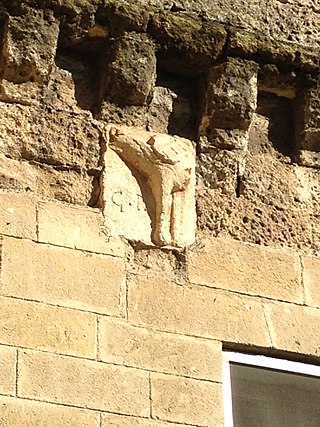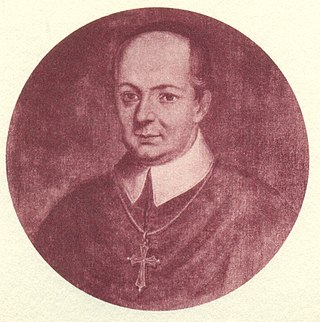Antonio Bulifon (1649-1707) was a French printer working in Naples. As a publisher Bulifon was "fundamentally important for the diffusion of women's poetry" in Italy. [1]
Antonio Bulifon (1649-1707) was a French printer working in Naples. As a publisher Bulifon was "fundamentally important for the diffusion of women's poetry" in Italy. [1]
Antonio Bulifon was born in Chaponay in Dauphiné in southeastern France, the son of Laurent Bulifon, a notary, and his wife Jeanne Pros. In 1668 he set out on travels across France, visiting shrines in Marseilles, Toulon and Aix, and continuing to Rome on hearing of the death of Pope Clement IX. [2] In 1670 he moved to Naples, where he established a printing firm. For his printer's device he chose a Siren, perhaps a symbol for his adopted city, and the motto “non sempre nuoce” (“she does not always harm”). [2] As a printer Bulifon specialized in travel books, histories of the city, and sixteenth-century lyric poetry. [3] He republished the fairy tales of Giambattista Basile. [2]
Bulifon's wealth of contacts, coupled with his virtual monopoly on the sale of foreign journals and books in Naples, transformed his bookshop into the primary conduit through which information and texts flowed freely in and out of the city. Not surprisingly, Bulifon's bottega became a gathering place for Neapolitan intellectuals including Giuseppe Artale, Francesco D'Andrea, Niccolò Toppi, Pompeo Sarnelli, Giovanni Vincenzo Gravina and Carlo Celano. The centrality of Bulifon's bookshop to Neapolitan intellectual life led foreign visitors from France, Germany, Switzerland, and England to his door. His shop became a mandatory stop for anyone traveling to Naples, as satisfied customers returned home and began to advertise his services. For example, after a trip to Naples in 1688, the author of Nouveau voyage d'Italie (1691), Maximilien Misson, described the printer as follows: “Mr. Bulifon, a bookseller, a native of France, but established for a long time in Naples, is not only clever in his trade, but knows an infinity of things, is the author of many good books and an exceedingly honorable man. He is extremely courteous to travelers and always ready to offer them his good offices”. [4]
Bulifon gave particularly noteworthy attention to women's work. [3] He republished the poetry of Vittoria Colonna in 1692 and 1693. Between 1692 and 1694 he also published the poems of Laura Terracina, Lucrezia Marinella, Veronica Gambara, Isabella Morra, Maria Selvaggia Borghini, Tullia d'Aragona, Laura Battiferri and Isabella Andreini, as well an anthology of fifty women poets. [5]
Around the start of the 18th century Bulifon turned his printing business over to his son Niccolo. When the Austrians invaded Naples in 1707, he fled to Spain and sought the protection of Philip V. His Naples bookshop was attacked and destroyed by a mob, and he died later that year. [2]


Vittoria Colonna, marchioness of Pescara, was an Italian noblewoman and poet. As an educated, married noblewoman whose husband was in captivity, Colonna was able to develop relationships within the intellectual circles of Ischia and Naples. Her early poetry began to attract attention in the late 1510s and she ultimately became one of the most popular poets of 16th-century Italy. Upon the early death of her husband, she took refuge at a convent in Rome. She remained a laywoman but experienced a strong spiritual renewal and remained devoutly religious for the rest of her life. Colonna is also known to have been a muse to Michelangelo Buonarroti, himself a poet.

Giovanni Bononcini was an Italian Baroque composer, cellist, singer and teacher, one of a family of string players and composers. He was a rival to George Frederic Handel.

The Basilica dei Santi Giovanni e Paolo, known in Venetian as San Zanipolo, is a church in the Castello sestiere of Venice, Italy.

Giugliano in Campania, also known simply as Giugliano, is a city and comune (municipality) in the Metropolitan City of Naples, Campania, Italy. A suburb of Naples, as of 2017, it had some 124,000 inhabitants, making it the most populated Italian city that is not a provincial capital.
Flavio Orsini was a papal bureaucrat, an Italian bishop, and a cardinal of the Catholic Church. He was son of Ferdinando Orsini, 5th duke of Gravina; and Beatrice Ferrillo, daughter and heiress of Giovanni Alfonso Ferrillo, Conte di Muro Lucano.

Adriana Basile was an Italian composer and singer.

Paolo Burali d'Arezzo was an Italian priest of the Theatine Order, a bishop, and cardinal of the Roman Catholic Church. His legal skills made him a prominent figure in the law courts of Naples, and then in the councils of government as a defender of the rights of citizens. He abandoned his career to pursue a calling to the religious state, where he became a leader in the Theatine Order. Pope Pius V elevated him to the cardinalate in 1570. He was considered a candidate for the Papacy in 1572, but his stern character did not recommend him to the electors. The new Pope, Gregory XIII, then promoted him to be the Archbishop of Naples, where he served from 1576 to 1578. After his death, he was recognized as beatified and worthy of official recognition by the Church.
Cesare Turco was an Italian painter of the Renaissance period. He was born in Ischitella near Foggia. He was a pupil of Giovanni Antonio d'Amato but afterwards studied under Andrea Sabbatini. He painted for the churches and public buildings of Naples. He painted the Baptism of Christ by St. John in Santa Maria delle Grazie presso le mura di Napoli and a Circumcision for the Jesuits' church. He also painted in Santa Maria la Nova and Sant'Agostino in Naples. Turco died in Naples.

Julius Caesar Capaccio was a learned Italian humanist of the 17th century. A civic humanist, in 1602 he was appointed secretary of the city of Naples.
Silvio Stampiglia was an Italian poet, librettist, and founder member of the Accademia dell'Arcadia under the pen name of Palemone Licurio. Numerous Italian composers set his libretti to music, particularly Carlo Agostino Badia and Giovanni Bononcini.

Sebastiano Biancardi, known by the pseudonym Domenico Lalli, was an Italian poet and librettist. Amongst the many libretti he produced, largely for the opera houses of Venice, were those for Vivaldi's Ottone in villa and Alessandro Scarlatti's Tigrane. A member of the Accademia degli Arcadi, he also wrote under his arcadian name "Ortanio". Lalli was born and raised in Naples as the adopted son of Fulvio Caracciolo but fled the city after being implicated in a bank fraud. After two years wandering about Italy in the company of Emanuele d'Astorga, he settled in Venice in 1710 and worked as the "house poet" of the Grimani family's theatres for the rest of his career. In addition to his stage works, Lalli published several volumes of poetry and a collection of biographies of the kings of Naples. He died in Venice at the age of 62.

Antonio Mongitore was a Sicilian presbyter, historian and writer, known for his works about the history of Sicily. He was also canon of the cathedral chapter of Palermo.

Marcello Papiniano Cusani was an Italian archbishop, professor of both civil law and canon law as well as founder and rector of the University of Altamura.

Giovanni Pipino di Altamura was an Italian nobleman and condottiero. He belonged to the Pipino noble family, which began with Giovanni Pipino da Barletta and that, after just a few decades, declined.
Giovanni Pipino da Barletta was an Italian nobleman and dignitary of the Kingdom of Naples. He started the Pipino noble family, which, after just a few decades, disappeared with the death of his grandson Giovanni Pipino di Altamura and his brothers.

Massacre of the Innocents is an altarpiece oil painting by Moretto da Brescia, executed in 1531–1532, originally painted on panel but later transferred to canvas. It is on display on a side altar in San Giovanni Evangelista church in Brescia.
Francesco Cassiano de Silva was a Spanish engraver. His engravings mainly depicted some cities of the Kingdom of Naples and they represent an invaluable source of information on the history of Southern Italy.

Pompeo Sarnelli was a Roman Catholic prelate who served as Bishop of Bisceglie (1692–1724).
Ambrogio Del Giudice, also known as Ambrosius de Altamura or just Altamura, was an Italian Dominican and historian.
Tommaso Costo was an Italian Renaissance humanist and writer.